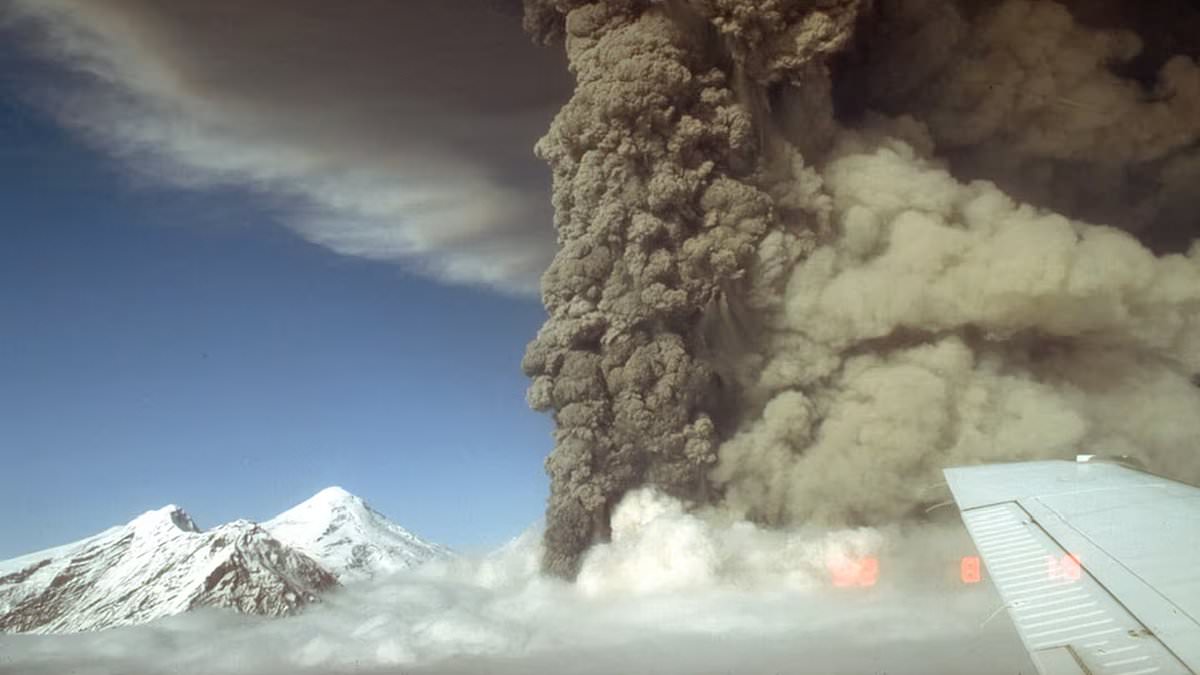An Alaskan volcano could blow at any time, and when it does, it will set of a chain reaction that would cause international chaos.
Mount Spurr is an 11,000-foot-tall that sits about 80 miles from Alaska’s most densely populated city, Anchorage, which is home to nearly 300,000 residents.
City residents are already bracing for a possible eruption, which experts say could happen in a matter of ‘weeks to months,’ but they won’t be the only ones impacted by this explosive event.
A massive cloud of ash billowing 50,000 feet into the air would force international hubs such as Ted Stevens Anchorage International Airport (ANC) and potentially Fairbanks International Airport (FAI) to shut down.
Halting all incoming and departing flights at these airports could have a ripple effect across the country, resulting in widespread delays and cancellations and even disrupting the global supply chain.
Hundreds of planes fly over Anchorage and Fairbanks per day, and it’s not just passenger flights that would be impacted. ANC is the fourth-busiest cargo airport in the world, with more than 8,000 cargo flights passing through each month.
Then last time Mount Spurr erupted in 1992, ANC shut down for 20 hours while the ash cloud hung over Anchorage. It darkened skies in the middle of the day, and ultimately settled an eighth of an inch thick across the city.
Now, experts monitoring the volcano’s activity warn it could blow again in a matter of ‘weeks to months.’
In a Tuesday morning update from the Alaska Volcano Observatory (AVO), experts said that unrest continues at Mount Spurr, with ‘frequent small volcanic earthquakes’ detected beneath the volcano over the past day.

When Mount Spurr blows, it will spew an enormous cloud of black ash 50,000 feet into the sky, and this will pose a significant hazard to airplanes because the particles are highly abrasive
‘Most of the earthquakes that are occurring under the volcano are too small to be located. Nothing unusual was observed in cloudy to partly cloudy webcam and satellite views,’ the update continued.
When Mount Spurr blows, the resulting ash cloud will pose a significant hazard to airplanes because the particles are highly abrasive.
Flying through an ash cloud can quickly damage windscreens, fuselage surfaces, compressor fan blades and even kill the plane’s engine. Ash particles can also cause critical navigational and operational instruments to fail.
All of this means that it is extremely dangerous to fly a plane while a volcanic eruption is occurring nearby. So, all airports in areas affected by the ash cloud will have to shut down.
ANC is perfectly positioned to transit freight between Asia and North America, which is why it is a major cargo hub.
Even moderate disruptions at this airport can delay freight shipments, e-commerce and manufacturing deliveries. A total shutdown would bring all of this to a screeching halt.
As for passenger flights, both ANC and FAI are also critical for polar and Pacific air routes.
Flights between North America and Asia, or the US and Europe, sometimes rely on these airports for diversion, refueling or emergency landings.

Mount Spurr is one of 53 volcanoes in Alaska. It sits 81 miles from Anchorage, which is home to nearly 300,000 people

When Mount Spurr blows, all airports in areas affected by the ash cloud will have to shut down. This will likely include international hubs such as Ted Stevens Anchorage International Airport (ANC) and potentially Fairbanks International Airport (FAI)
Closing them would force incoming passenger flights to re-route, resulting in longer flight times and congestion at alternate airports.
Any departing flights from these airports would be grounded until the ash cloud clears, which could take hours or days depending on how long the eruption lasts.
Therefore, Mount Spurr has the potential to snare travel and cargo logistics, resulting in disruptions that extend far beyond the Alaskan border.
The last time this volcano erupted was in 1992, when it saw three back-to-back explosive events in July, August and September.
During the August eruption, ANC shut down for about 20 hours, impacting commerce and transportation.
The Municipality of Anchorage reported nearly $2million in damages, office closures and cleanup costs from the August eruption.
No one was killed by these events directly. But two heart attacks, one fatal, from shoveling ashfall were reported in Anchorage.
Breathing in ash also poses a health hazards. The tiny particles can work their way deep into the lungs, worsening symptoms for people with respiratory conditions such as asthma or bronchitis.

A resurfaced video taken on August 18, 1992 shows an enormous black cloud of ash billowing out of Mount Spurr’s side vent, Crater Peak
If Spurr blows again, the event ‘would be explosive,’ Matt Haney, scientist-in-charge at the Alaska Volcano Observatory (AVO), previously told DailyMail.com, adding that it would probably look similar to Mount Spurr’s last eruption in 1992.
Read More
EXCLUSIVE
The 'inevitable' US disasters that keep scientists up at night

He and his colleagues at the AVO have been monitoring the volcano’s heightened activity since April 2024, keeping track of shallow earthquakes, ground deformation, and gas and steam emissions.
All of these are signs of an impending eruption.
If Mount Spurr’s activity continues to ramp up, the next sign of an eruption will be a volcanic tremor, Haney said.
This would be different from the brief, shallow earthquakes this volcano has already been experiencing.
A volcanic tremor is a longer stretch of ongoing shaking that can persist for minutes to days.
It occurs when magma beneath the volcano begins rising toward the surface as the eruption grows imminent.
Back in June 1992 — the last time Mount Spurr erupted — volcanic tremors began about three weeks before it finally blew.
